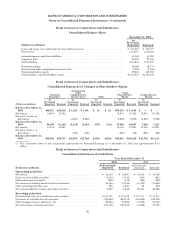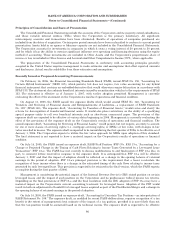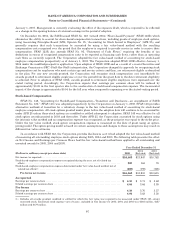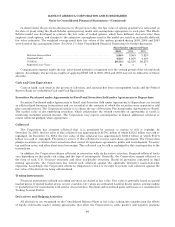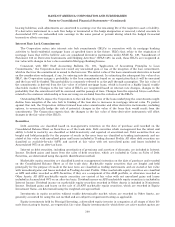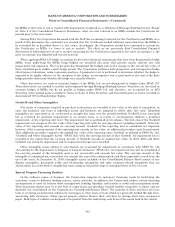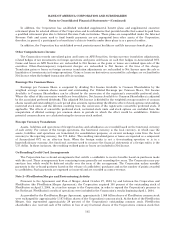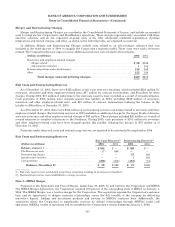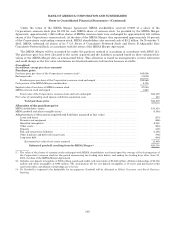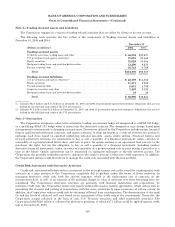Bank of America 2005 Annual Report Download - page 138
Download and view the complete annual report
Please find page 138 of the 2005 Bank of America annual report below. You can navigate through the pages in the report by either clicking on the pages listed below, or by using the keyword search tool below to find specific information within the annual report.BANK OF AMERICA CORPORATION AND SUBSIDIARIES
Notes to Consolidated Financial Statements—(Continued)
consumer loans and leases, and performing commercial loans and leases. Included within this second component of the
Allowance for Loan and Lease Losses and determined separately from the procedures outlined above are reserves which
are maintained to cover uncertainties that affect the Corporation’s estimate of probable losses including the imprecision
inherent in the forecasting methodologies, as well as domestic and global economic uncertainty and large single name
defaults or event risk. Management evaluates the adequacy of the Allowance for Loan and Lease Losses based on the
combined total of these two components.
In addition to the Allowance for Loan and Lease Losses, the Corporation also estimates probable losses related to
unfunded lending commitments, such as letters of credit and financial guarantees, and binding unfunded loan
commitments. Unfunded lending commitments are subject to individual reviews and are analyzed and segregated by
risk according to the Corporation’s internal risk rating scale. These risk classifications, in conjunction with an analysis
of historical loss experience, current economic conditions, performance trends within specific portfolio segments and any
other pertinent information, result in the estimation of the reserve for unfunded lending commitments.
The allowance for credit losses related to the loan and lease portfolio, and the reserve for unfunded lending
commitments are reported on the Consolidated Balance Sheet in the Allowance for Loan and Lease Losses, and Accrued
Expenses and Other Liabilities. Provision for Credit Losses related to the loans and leases portfolio and unfunded
lending commitments are reported in the Consolidated Statement of Income in the Provision for Credit Losses.
Nonperforming Loans and Leases
Credit card loans are charged off at 180 days past due or 60 days from notification of bankruptcy filing and are not
classified as nonperforming. Unsecured consumer loans and deficiencies in non-real estate secured loans are charged off
at 120 days past due and not classified as nonperforming. Real estate secured consumer loans are placed on nonaccrual
status and classified as nonperforming at 90 days past due. The amount deemed uncollectible on real estate secured
loans is charged off at 180 days past due. Consumer loans are generally returned to performing status when principal or
interest is less than 90 days past due.
Commercial loans and leases that are past due 90 days or more as to principal or interest, or where reasonable
doubt exists as to timely collection, including loans that are individually identified as being impaired, are generally
classified as nonperforming unless well-secured and in the process of collection. Loans whose contractual terms have
been restructured in a manner which grants a concession to a borrower experiencing financial difficulties, without
compensation on restructured loans, are classified as nonperforming until the loan is performing for an adequate period
of time under the restructured agreement. In situations where the Corporation does not receive adequate compensation,
the restructuring is considered a troubled debt restructuring. Interest accrued but not collected is reversed when a
commercial loan is classified as nonperforming. Interest collections on commercial nonperforming loans and leases for
which the ultimate collectibility of principal is uncertain are applied as principal reductions; otherwise, such collections
are credited to income when received. Commercial loans and leases may be restored to performing status when all
principal and interest is current and full repayment of the remaining contractual principal and interest is expected, or
when the loan otherwise becomes well-secured and is in the process of collection.
Loans Held-for-Sale
Loans held-for-sale include residential mortgage, loan syndications, and to a lesser degree, commercial real estate,
consumer finance and other loans, and are carried at the lower of aggregate cost or market value. Loans held-for-sale are
included in Other Assets.
Premises and Equipment
Premises and Equipment are stated at cost less accumulated depreciation and amortization. Depreciation and
amortization are recognized using the straight-line method over the estimated useful lives of the assets. Estimated lives
range up to 40 years for buildings, up to 12 years for furniture and equipment, and the shorter of lease term or estimated
useful life for leasehold improvements.
Mortgage Servicing Rights
Pursuant to agreements between the Corporation and its counterparties, $2.2 billion of Excess Spread Certificates
(the Certificates) were converted into MSRs on June 1, 2004. Prior to the conversion of the Certificates into MSRs, the
Certificates were accounted for on a mark-to-market basis (i.e. fair value) and changes in the value were recognized as
Trading Account Profits. On the date of the conversion, the Corporation recorded these MSRs at the Certificates’ fair
market value, and that value became their new cost basis. Subsequent to the conversion, the Corporation accounts for
102





